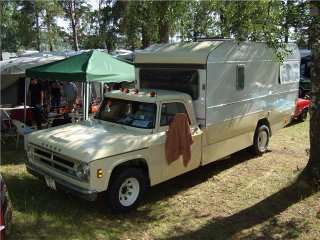| Subject: |
|
Mopar Electronic Ignition Troubleshooting |
| Name: |
|
JimmieD |
| Date Posted: |
|
Aug 22, 08 - 10:32 PM |
| IP Address: |
|
66.81.199.89 |
| Dodge-Link |
|
http://youtube.com/watch?v=e-LOtKIIKcg |
| Message: |
|
Mopar Electronic Ignition Troubleshooting
Remember that Mopar ECU & voltage regulator must have clean bare metal ground, plus ECU requires fully charged battery for the voltage shot to transistor.
The 5 wire ECU & connector has a spare wire terminal not used in 4 wire ECU, green with red stripe, which is an auxiliary ground lead. You can use a 5 wire ECU in a 4 Wire ECU vehicle but not vice versa, as no 4-wire ECU works in a 5-wire vehicle.
Distributor magnetic pickup to reluctor air gap should be set to about .006 with a brass feeler gauge.
Tests: With the ignition key in the cranking or 'Start' position you should have full 12 volts to ballast resistor and coil positive. This drops to something like 9 volts in 'Run' circuit, of ballast resistor.
To quickie wire up an ECU connect one wire from the 'IGN' pole on the ignition switch to one side of the single ballast resistor and from the other side run a wire to the side of the coil. This drops voltage in the 'Run' position. Now run a wire from the 'START' pole of switch to the other side of resistor, the coil side. This gives you full 12v for starting.
I believe most big blocks have counter-clockwise rotation of distributor rotor, small blocks clockwise.
Remember that engine-to-firewall ground strap is required, clean bare metal ground on both ends.
If engine just doesn't want to start check ballast resistor, they are a common fault. Some will only start as you release key from 'Start' cranking position to 'Run' position, indicating a bad ballast resistor.
Mopar Electronic Ignition Testing:
It is critical to proper operation of ignition to make sure there is a solid bare-metal ground between ECU case and ground and between Regulator case and ground. Sometimes a jumper wire is needed.
1] Check voltage at ECU wiring connector cavity 1, with negative lead to ground and positive lead to pin 1 socket. One 'side' of connector is rounded, the other side has a sharp peak, and the cavity directly below sharp peak with peak facing left is pin 1 on connector wire plug. You should show at least 11 volts with ignition 'On' and all accessories off.
This connector's Pin 1 wire goes to the dual ballast resistor connection where there is a jumper wire between the two resisted circuits. In other words, this is from the ignition switch terminal to ballast jumper to pin 1 cavity.
2] This same test is to be repeated at cavity 2 and 3, which are the next two cavities in a clockwise direction, facing female ECU connector end with the peak above pin 1 cavity to your left side. These are the primary wiring system tests for voltage presence:
3] Turn off ignition and switch to Ohm's/Resistance scale on VOM Multimeter, connecting test leads between cavities 4 and 5. The reading should be somewhere between 150 to 900 Ohms.
4] If the resistance in previous test is not within specification disconnect the distributor's dual wire connector. Perform the same test, between the two wire terminals at dual wire connector on distributor side of connection. Readings should be within the same specification, 150-900 Ohms. If it isn't the pickup coil assembly is faulty and needs replacement.
5] Connect Ohmmeter negative lead to ground and positive lead to either wire connector on distributor side of dual lead. Each connector should show infinity or open circuit. If not, replace pickup coil.
6] The Electronic Ignition ECU must be grounded to bare metal. Connect one lead of Ohmmeter to ground and the other lead to the ECU pin 5 , on a 5 pin ECU control box. There should be continuity, as pin 5 on ECU is the ground connection to igniion circuits. If no continuity is present between pin 5 and ground then tighten the unit's mounting screws and recheck. If there's still no continuity to ground replace the ECU. 4 pin ECU's don't use this ground lead.
7] WITH IGNITION SWITCH 'OFF' reconnect the wiring connector to ECU and dual-wire distributor connector. Note: NEVER connect or disconnect Voltage Regulator or ECU with ignition switch on, and always disconnect a battery lead before connect/disconnect of Regulator.
8] Remove high voltage secondary lead from center of distributor cap and hold it about 3/16" to 1/4" from a bare metal ground. Have someone crank engine with ignition switch and check for spark to ground. If no spark is seen after above tests replace ECU control unit.
9] After replacing ECU crank engine and test again in the same way. If no spark is seen replace ignition coil.
10] Adjust air gap between reluctor and pickup coil to .006 with a brass feeler gauge strip.
I post these links periodically, hoping guys will put them in an 'Electrical Repairs' folder in their Favorites / Bookmarks:
http://www.allpar.com/history/mopar/electrical.html
http://www.allpar.com/history/mopar/electrical2.html
http://www.madelectrical.com/electricaltech/amp-gauges.shtml
Be sure to click for page 2 on above link.
Other Mad info:
http://www.madelectrical.com/electrical-tech.shtml
Other Mopar ignition info:
http://www.moparaction.com/Tech/questions/ELECTIFYING.html
http://www.mopar1.us/charge.html
http://www.mopar1.us/electronic.html
This should get you started or keep you running.
[Copyright DTA 2008] |
|
Replies:
|
|
|
|
|








 Reply
Reply Home
Home bravenet.com
bravenet.com